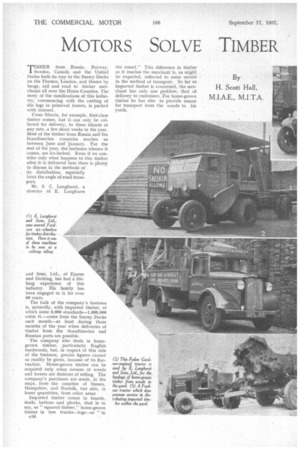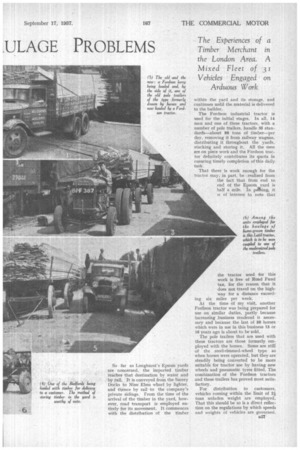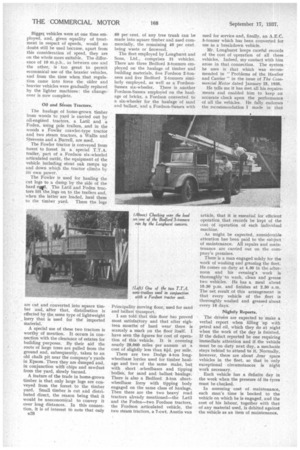MOTORS SOLVE TIMBER ULAGE PROBLEMS
Page 46

Page 47

Page 48

If you've noticed an error in this article please click here to report it so we can fix it.
'TIMBER from Russia, Norway., I Sweden, Canada and the United States finds its way to the Surrey Docks on the Thames. London, and thence by barge, rail and road to timber merchants all over the Horne Counties. The story of the ramifications of this industry, commencing with the cutting of the logs in primeval forests, is packed with interest.
From Siberia, for example, first-class timber comes, but it can only be collected for delivery, to these islands at any rate, a few short weeks in the year. Most of the timber from Russia and the Scandinavian countries reaches us between June and January. For the rest of the year, the harbours whence it comes, are ice-locked. Even if we consider only what happens to this timber after it is delivered here there is plenty to discuss in the methods of its distribution, especially from the angle of road transport.
Mr. S C. Longhurst, a director of E. Longhurst and Sons, Ltd., of Epsom and Dorking, has had a lifelong experience of this industry. His family has been engaged in it for over 60 years.
The bulk of the company's business is, naturally, with imported timber, of which some 6,000 standards-1,000,000 cubic ft.—come from the Surrey Docks each month—at least during those months of the year when deliveries of timber from the Scandinavian and Russian ports are possible.
The company also deals in homegrown timber, particularly English hardwoods, but, in respect of this side of the business, precise figures cannot so readily be given, because of its fluctuation. Home-grown timber can be acquired only when owners of woods and forests are desirous of Selling. The company's purchases are made, in the main, from the counties of Sussex, Hampshire, and Norfolk, but also, in lesser quantities, from other areas Imported timber comes in boards, deals, battens and planks, that is to say, as "squared timber," home-grown timber in tree trunks—logs—or " in a:41 the round." This difference in timber as it reaches the merchant is, as might be expected, reflected to some extent in the method of transport. So far as imported timber is concerned, the merchant has only one problem, that of delivery to customers. For home-grown timber he has also to provide means for transport from the woods to his yards.
So far as Longhurst's Epsom yards are concerned, the imported timber reaches that destination by water and by rail. It is conveyed from the Surrey Docks to Nine Elms wharf by lighter, and thence by rail to the company's private sidings. From the time of the arrival of the timber in the yard, however, road transport is employed entirely for its movement. It commences with the distribution of the timber within the yard and its storage, and continues until the m1iterial is delivered to the builder.
The Fordson industrial tractor is used for the initial stages. In all, 14 men and one of these tractors, with a number of pole trailers, handle 35 standards—about 98 tons of timber—per day, removing it from railway wagons, distributing it throughout the yards, stacking and storing it. All the men are on piece work and the Fordson tractor definitely contributes its quota in ensuring timely completion of this daily task.
That there is work enough for the tractor may, in part. be -.realized from
the fact that from end to end of the Epsom...yard is half a mile. In ping, it is of interest to note that
the tractor used for this work is free of Road Fund tax, for the reason that it does not travel on the highway for a distance exceed At the time of my visit, another Fordson tractor was being prepared for use on similar duties, partly because increasing ,business rendered it necessary and because the last of 88 horses which were in use in this business 15 or 16 years ago is about to be sold.
The pole trailers that are used with these tractors are those formerly employed with the horses. Some are still of the steel-rimmed-wheel type as when horses were operated, but they are steadily being converted to be more suitable for tractor use by having new wheels and pneumatic tyres fitted. The combination of the Fordson tractors and these trailers has proved most satisfactory.
For distribution to customers, vehicles coming within the limit of 24 tons unladen weight are employed. That this should be so is a direct reflection on the regulations by which speeds and weights of vehicles are governed. Bigger vehicles were at one time employed, and, given equality of treatment in respect of speeds, would no doubt still be used because, apart from this consideration of speed, they are on the whole more suitable. The difference of 10 m.p.h., as between one and the other, is too great to permit economical use of the heavier vehicles, and from the time when that regulation came into force the older and heavier vehicles were gradually replaced by the lighter machines: the changeover is now complete.
Oil and Sieam Tractors.
The haulage of home-grown timber from woods to yard is carried out by oil-engined tractors, a Latil and a Foden, using pole trailers, and in the woods a Powler crawler-type tractor and two steam tractors, a Wallis and Steevens and a Burrell, are used.
The Fowler tractor is conveyed from forest to forest in a special T.T.A. trailer, part of a Fordson six-wheeled articulated outfit, the equipment of the vehicle including stout oak ramps up and down which the tractor climbs by its own power.
The Fowler is used for hauling the cut logs to a dump by the side of the hard yap. The Latil and Foden tractors lift the logs on to the trailers and, when the latter are loaded, haul them to the timber yard. There the logs are cut and converted into square timber and, after that, distribution is effected by the same type of lightweight lorry that is used for the imported material.
A special use of these two tractors is worthy of mention. It occurs in connection with the clearance of estates for building purposes. By their aid the roots of large trees are pulled from the ground and, subsequently, taken to an old chalk pit near the company's yards in Epsom. There they are dumped and, in conjunction with chips and sawdust from the yard, slowly burned.
A feature of the trade in home-grown timber is that only large logs are conveyed from the forest to the timber yard. Small timber is cut and distributed direct, the reason being that it would be uneconomical to convey it over long distances. In this connection, it is of interest to note that only n3S 60 per cent. of any tree trunk can be made into square timber and used commercially, the remaining 40 per cent. being waste or firewood.
The fleet employed by Longhurst and Sons, Ltd., comprises 31 vehicles. There are three Bedford 3-tonners employed on the haulage of timber and building materials, five Fordson 2-tonners and five Bedford 2-tonners similarly employed, as well as a FordsonSussex six-wheeler. There is another Fordson-Sussex employed on the haulage of bricks, a Fordson converted to a six-wheeler for the haulage of sand and ballast, and a Fordson-Sussex with Principality moving floor, used for sand and ballast transport.
I am told that this floor has proved most satisfactory and that after eighteen months of hard wear there is scarcely a mark on the floor itself. I have seen the figures for cost of operation of this vehicle. It is covering nearly 28,000 miles per annum at a cost of slightly less than 61{1. per mile.
There are two Dodge 4-ton longwheelbase lorries used for timber haulage and two of the same make, but with short -wheelbases and tipping bodies, for sand and ballast haulage. There is also a Bedford 3-ton shortwheelbase lorry with tipping body engaged on the same class of haulage. Then there are the two heavy road tractors already mentioned—the Latil and the Foden—two Fordson tractors, the Fordson articulated vehicle, the two steam tractors, a 7-cwt. Austin van
used for service and, finally, an A.E.C. 5-tonner which has been converted for use as a breakdown vehicle.
Mr. Longhurst keeps careful records of the cost of operation of all these vehicles. Indeed, my contact with him arose in that connection. The system he uses is that which was recommended in "Problems of the Haulier and Carrier" in the issue of The Commercial Motor dated January 25, 1935.
He tells me it has met all his requirements and enabled him to keep an accurate check upon the performance of all the vehicles. He fully endorses the recommendation I made in that article, that it is essential for efficient operation that records be kept of the cost of operation of each individual machine.
As might be expected, considerable attention has been paid to the subject of maintenance. All repairs and maintenance are carried out on the company's premises.
There is a man engaged solely for the work of washing and greasing the fleet. He comes on duty at 4.30 in the afternoon and his evening's work is thoroughly to wash, clean and grease two vehicles. He has a meal about 10.30 p.m. and finishes at 2.30 a.m. The net result of this arrangement is that every vehicle of the fleet is thoroughly washed and greased about every 16 days.
Nightly Reports.
The drivers are expected to make a verbal report when filling up with petrol and oil, which they do at night when the work of the day is finished. If the defect reported be one requiring immediate attention and if the vehicle must be on duty next day, a mechanic stays behind to attend to it. Normally, however, there are about -four spare vehicles in the fleet, so that in only exceptional circumstances is night work necessary.
Each vehicle has a definite day in the week when the pressure Of its tyres must be checked.
In assessing cost of maintenance, each man's time is booked to the vehicle on which he is engaged, and the cost of his labour, together with that of any material used, is debited against the vehicle as an item of maintenance.




















































































